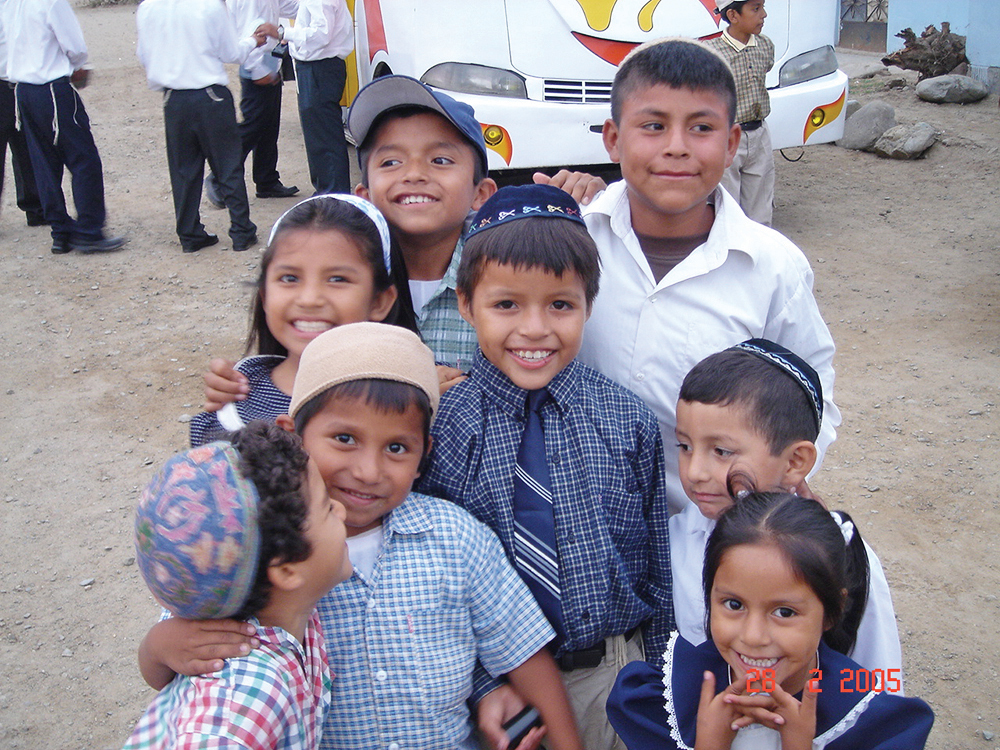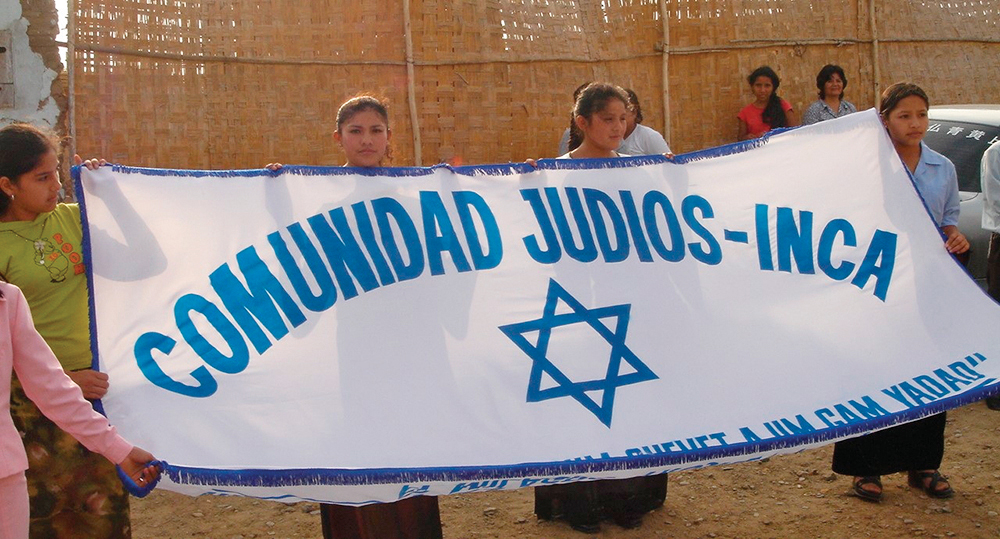
According to Rebbetzin Sara Blumenfeld, the history of how Jews first came to be in Peru needs to be told in three parts. She is the widow of Rabbi Schneur Zalman Blumenfeld, z”l, who was director of Chabad Lubavitch of Peru and senior shaliach to Peru. Today, she continues to run the Chabad House and all of its activities, with the help of some of her children. Her son Moshe runs the shul and the rabbinical aspects and her daughter Reiza is the office manager.
“According to many scholar’s opinions,” Rebbetzin Blumenfeld shared with The Jewish Link, “the first Jewish mention of Peru is probably in the Tanach. When Shlomo Hamelech was building the Beis Hamikdash, he sent his workers to ‘Ofir’ to get gold. In the past, Peru used to be called Ofir, so the understanding is that they came to Peru to get gold.”
The second part, she continued, is that the first Jewish community in Peru was in the time of Columbus. “There are many mentions in history of how most of his group were Jewish people running away from the Inquisition in Spain. Some were also prisoners who were sent as a punishment to help conquer this side of the world. With the … Inquisition, Lima became the capital of the Spanish Inquisition in [South] America.
“Today there are many non-Jewish local Peruvian families who have Spanish last names and claim to be Jewish descendants, but according to halacha they don’t have any Jewish connection” said Rebbetzin Blumenfeld. “In the center of Lima, there is a street called Street of the Jews and Jerusalem Street and more, near the square where the ‘Autos da Fe’ [rituals of public penance during the Inquisition] were.”

And the third part is about the current Jewish community in Peru. The rebbetzin continued: “In the late 1700s and during the 1800s, Jews started migrating from Europe, Turkey and other Sefardi countries to Peru, for better business opportunities, for marriage or because it was the only place that gave them a visa. During the best times, there were about 7,000 Jews living in Peru and more than a dozen minyanim in the country. Then, Jews were living in many cities around Peru.
“It was only around 1940 that Lima became the main Jewish city in Peru. Today, the Jewish community of Peru is in Lima, while some other cities have one or some Jews living there. Officially there are about 3,000 Jews in Peru but at least 1,000 of them are not Jewish according to halacha because of marriage with non-Jews.”
Peru was also once the home to the Bnei Moshe. This community, also known as “Inca Jews,” today no longer exists. The Bnei Moshe do not claim Jewish ancestry. In 1958, in the city of Cajamarca and the surrounding area, there was a local Peruvian family: two brothers, Alvaro and Segundo Villanueva Correa, who became very interested in studying the Torah, and decided to embrace Judaism. They were then part of the Church. However, they separated from the Church in order to study Tanach and start keeping mitzvot. They began to keep Shabbat, the Jewish holidays and the laws of kashrut. Many families in their city started following their lead, some for faith, some for economic reasons. With time, they continued to become very attached to Judaism and asked for help from rabbis to allow them to convert to Judaism and eventually make aliyah and become part of the Jewish nation.
Their leader, Zrubavel Tzidkiya, the Hebrew name taken by Segundo Villanueva Correa, was very strong in his belief; the group that converted with him, about 200 people, became God-fearing Jews and very frum in their keeping of mitzvot. Segundo’s brother, Alvaro, however, did not complete the conversion process.
“During this time, the Bnei Moshe contacted the Lubavitch Headquarters in Brooklyn,” said the rebbetzin’s daughter, Reiza, “but the details of the conversations aren’t known to us. And many years later when the last members who converted according to halacha were making aliyah and on their way to Israel, they were in touch with Rabbi Blumenfeld and visited the Chabad House to learn more about mitzvot.”
Michael Freund, founder of of Shavei Israel, a unique nonprofit organization dedicated to assisting descendants of Jews and the Lost Tribes of Israel reclaim their roots, said: “Regarding the Bnei Moshe, it is important to note that they underwent conversion by a beit din sent by the Chief Rabbinate of Israel, thus demonstrating how serious they were about living a life of Torah and mitzvot. Shavei Israel was involved in arranging and facilitating the conversion of many of the Bnei Moshe community members.”
Rebbetzin Blumenfeld noted: “Today there is nobody left from that community in Peru. There is only the house they used as their synagogue where non-Jews go to pray, and their family members who did not want to complete the process of converting but did adopt some Jewish customs. It is possible to visit the descendants of the Bnei Moshe in Israel. They mostly live in the Shomron.”
In the last 15 years, Peru has become a very popular place for tourists to visit. The Chabad House in Lima was established in 1987 and has become a center of Jewish life in Peru. The Chabad House is located in Isidro, an upscale neighborhood where approximately 80% of the Jewish community is found. Here, too, are the other shuls, the Jewish school of Lima and the Jewish museum of the Holocaust.
Reiza Blumenfeld noted: “Prior to Rabbi and Rebbetzin Blumenfeld establishing the Chabad House, Jewish life in Peru was very limited. People attended the synagogue for Yom Kippur or to say Kaddish. Kosher food was available only for a handful of families. Yearly kosher shechita used to be 300 chickens and two cows. Today it is about 8,000 chickens and about 100 bulls. And now there are many more people who are involved in being a Jew and keeping Jewish life.”
“We get a few hundred Jewish kosher travelers per year,” said Rebetzin Blumefeld. “Lima is a stopover place so they usually stay in Peru for a day or three. The kashrut at the Chabad House is according to the highest standards and we have daily three running kitchens where people can acquire kosher food for breakfast, lunch or dinner or just snacks during the day. Tourists can write to us for information on what they can find kosher in the supermarkets or in our Chabad House.”
At the Chabad House, the traveler can find daily minyanim, three mikvahs (for women, men and utensils), twice-a-year kosher shechita for chicken and meat, and twice-a-month fresh Cholov Yisrael milk and cheese. There is also a kosher bakery as well as kosher catering and activities in the synagogue for the Jewish community and travelers. The Chabad House distributes weekly dvar Torah pamphlets to the community and something for each Yom Tov, such as matzah for Pesach, mishloach manot for Purim and a yearly Jewish book for each Jewish home. Travelers can eat at the Chabad House but accommodations must be found elsewhere. Hotels in Lima do not serve kosher food.
Lima has a rich culture to explore, and today the Jewish traveler can easily visit and travel in Peru. There are hotels and Airbnbs located near the Chabad House.
Visitors to Lima can also arrange to take a tour in the city center that focuses on Lima’s secret Jewish community of the 16th and 17th centuries, seeing where the community lives today and learning the history of many possible crypto-Jews, such as Francisco Pizarro, conquistador of Peru and founder of Lima. Also of interest in Lima: The House of Pilate (Casa de Pilatos) built in 1590, is one of the oldest houses in the city. Casa de Pilatos was used by Jews as a secret hiding place from the Inquisition in colonial times. Supposedly the downstairs cellar was used for Friday services.
The Miraflores neighborhood is near the ocean. Approximately 15% of the Jewish community lives there. Many visitors stay there, as Miraflores has four-star hotels with ocean views. This neighborhood is about a 10-15 minute drive from the Chabad House and a 40-minute to one-hour walk for Shabbat. Barranco is another neighborhood visitors can explore. It is an “artsy” neighborhood, approximately a 30-minute walk from Miraflores.
Guides also offer city tours in the center of Lima or the Miraflores and Barranco neighborhoods. There are many day tours around the city, two- to five-hour rides, sand, water or ice views. Visitors can also hire a driver or tour guide who will help with exploring other cities in Peru, such as Las Lomas de Lucumo in Pachacamac, which is an ecosystem close to Lima. Las Lomas de Lucumo is ideal for practicing adventure sports or outdoor activities. Lunahuana, a small Peruvian town south of Lima, offers ancient ruins, outdoor activities, scenic walking areas, landmarks, boat tours and more.
The kosher traveler to Peru will find much to experience, and in Lima can always check in with Rebbetzin Blumenfeld at the Chabad House with any questions.
For more information: Chabad of Peru, WhatsApp +1-443-770-3075 / +51-999-770-998. Email: [email protected]. Donate: JabadPeru.com
Shavei Israel: +972-2-625-6230. Email: [email protected]
Susan R. Eisenstein is a longtime Jewish educator, passionate about creating special, innovative activities for her students. She is also passionate about writing about Jewish topics and about Israel. She has two master’s degrees and a doctorate in education from Columbia University.












